Tough love: is this a model prison for children?
Last month, 14 young people were compensated for their mistreatment in British prisons. What can we learn from a groundbreaking scheme for young offenders in Spain?
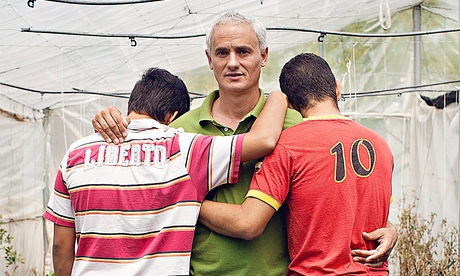
From a distance, La Zarza re-educational centre, deep in the heart of the Murcian countryside, looks like any other jail – high fences topped with rolled razor wire and a uniformed guard manning the gate. But a close inspection of the fences reveals gaps in the wire big enough for any agile teenager to get through, and inside there is a white horse, grazing in a small paddock. The children – the prisoners, because this is a prison – are allowed to ride the horse, but only when they have reached a certain stage in their development.
To the left children are playing on a five-a-side football pitch. Of 61 offenders, three are murderers, many have committed armed robbery and virtually all had drug problems when they arrived.
While Spain’s adult prisons are almost as overcrowded as Britain’s and similarly rife with discipline problems, youth detention is a different matter. Twenty-three years ago, a not-for-profit organisation, Diagrama, opened its first re-education centre in Spain. Now it runs 38 such centres and is responsible for virtually all of the Spanish youth custody system. Before, Spain locked up children in similar conditions to adults, and when children in custody reached the age of 18, they would automatically be transferred to adult jails. But in 1992, a law was passed requiring the juvenile justice system to operate according to international rules and standards on children’s rights. The understanding was that if children were going to be jailed, they would also have to be nurtured, educated and rehabilitated.
In Britain, meanwhile, detention centres for children go from controversy to controversy. Since 1990, 33 children under 18 in England and Wales have died in custody, 31 of whom killed themselves. In total, 291 inmates under 21 have died in detention in the same period; 264 of them took their own lives.
Diagrama has not had a single suicide in any of its centres since it began operating. The founder and current chair is Francisco Legaz. A psychologist, he worked with children in the Spanish penal system, but became disillusioned with their treatment. Using his own money he bought the land La Zarza stands on and persuaded the authorities to let him run a centre using different methods. His staff say he works 24/7 and is always investigating new ways to improve the system.
The main difference between Spanish and British detention centres is philosophical. In Britain, the children tend to be regarded as inmates. Here, they are always children. In Britain, a good day is one without violence or disturbance. Here, a good day is one when the children have learned well and made progress. Perhaps the biggest practical difference is the level and nature of staffing. In Britain, training assistants are glorified guards (teachers go in to educate the children and are hired by the local authority); in Spain the staff who run the centres are called educators. British training assistants do not need qualifications; in Spain, educators all have degrees.
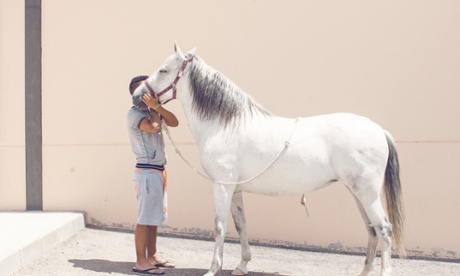
In Spain’s stifling afternoon heat, Diagrama regional director Jesus Teruel greets Ainhoa, the mother of one of the children, with kisses on both cheeks. Teruel is a tall, passionate man with the manic energy of a cartoon character. As he answers questions, his eyes and hands dart in different directions. Yes, of course he knows the names of all the children detained in the region, he says. Yes, of course he knows all the parents. If he didn’t, he wouldn’t be doing his job.
Ainhoa lives an hour away and visits once a week. In the UK, it is common for children to be locked up hundreds of miles from home, but Teruel says it’s important for children to be detained as close as possible to their family. Ainhoa’s son, Daniel, is 16 and has been here for four months. His offence is sexual harassment. Ainhoa was terrified when he was sentenced. He was on antidepressants and told her he would rather be dead than in prison. When he arrived, he was put on suicide watch. For several nights, an educator stayed in the same room as him, with the door open. Now he is off medication and the suicidal thoughts have gone. Ainhoa says her son is getting discipline but also affection at La Zarza. Affection is a word we hear a lot.
Does she have any complaints about La Zarza? She thinks, then smiles. “It takes him a while to answer the phone. Maybe they could get him quicker.” She is allowed to call twice a day to speak to her son. In Britain, parents cannot call children in detention. Children are allowed to phone home, but only if they have credit. All their calls are made within sight and sound of other children and staff.
***
“So mum if you are reading this I am not alive cos I can not cope in prison people giving me shit even staff.” Note found in the cell of Jake Hardy, 17, on 20 January 2012
Jake Hardy was a big lad, 6ft 4in, but had the mind of a child. He was bullied from day one at Hindley young offender institution in Wigan, run by the Prison Service. One Wednesday night, he smashed his TV and cut his wrist with the broken glass. The next night he could not phone his mother because he had no credit. On the Friday, he had credit, but did not come out on association – when calls are made – because of the bullying. He would often cry on the phone, which led to more taunts, so staff would let him use the phone before association. That night they forgot and told him he could phone afterwards. During association, children repeatedly taunted him through his cell door. Jake banged and kicked his door in frustration. Consequently, staff told him he could not phone his mother. “We cannot reward bad behaviour,” one later said. That night, Jake hanged himself. The inquest jury returned a damning verdict of the regime at Hindley, citing 12 failures by staff that contributed to his death.
Two days before he died, his mother had reported to a senior officer that he had told her he was “thinking of ending it”, yet no special measures had been taken to protect him. She said if he had been able to make that call, she could have talked him out of it.
***
Ainhoa is open-mouthed when she hears the story of Jake Hardy. She is so shocked, she can’t respond. Teruel says if such a thing happened under his watch, he would go to jail.
As soon as children arrive at La Zarza, they are put through an induction lasting around 20 days, during which they are medically and psychologically assessed. Every day they see a psychologist who draws up an individual programme for each child. In England and Wales, the child meets the judge and prosecutor only in court, but here they visit the centres every three months. Children can see them at any time if they have concerns about their treatment. If they are making exceptional progress, staff can ask the judge to reconsider the sentence.
While in England and Wales, the age of criminal responsibility is 10, in Spain it is 14. Between 14 and 16, the maximum sentence a child can receive is four years, irrespective of the crime; between 16 and 18, it’s eight years. If children are sentenced before they are 18, they serve all their sentence in re-education centres. (In England and Wales, they would be transferred to a separate section of a young offender institution on reaching 18.) In Spain, at 18, their criminal record is cleared.
There are 61 beds at La Zarza. Girls account for about 5% of the population – roughly the same as in England. Staffing levels would make the bean counters at the Ministry of Justice quail: there are 80 educators who play no role in any physical restraint of the children should it be required; 20 semi-educators, who can be called upon to use force if necessary; and seven security guards who are solely responsible for security and good order, and play no part in the children’s everyday lives.
In fact, they are seldom needed. In the past year, restraint has been used three times, all to prevent self-harm. The security guards carry handcuffs and batons, but the director of La Zarza, José Marco, insists they have never been used. Self-harm does occur, but rarely, and usually at the start of a child’s sentence. There have been no escapes; a boy who failed to return from a home visit was brought back and sent backwards in his programme.
It’s hard to monitor, because their criminal records are cleared at 18, but Diagrama claims a 70% reintegration rate for its youth offenders – almost the inverse of England and Wales, where the reoffending rate is 73%.
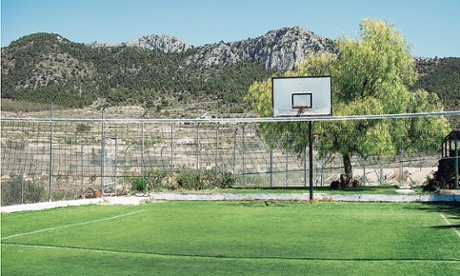
Mateo is 19 and this is his second time in La Zarza, so he’s one of the failures. His friend Diego is 14. The boys say they don’t know what offences others have committed. “We are not allowed to ask this,” Mateo says. “We can speak to staff about our crimes, but not to other children.”
Mateo says he thought he would go straight after his first spell inside, but he encountered problems at home and fell back into his old ways. He has been back at La Zarza for 13 months, is at the semi-open stage of his time there and has won the right to go home for the weekend in a few days. An accomplished flamenco singer and guitarist, he gives us a burst of song. He has been allowed out of the centre to take part in competitions. How does he describe the staff? “Teachers,” he replies without hesitation.
Diego rests his arm on the older boy’s shoulder. Children are allowed to touch each other in this way, but even the slightest hint of play-fighting attracts sanctions. Similarly, children are not allowed to raise their voice in argument. The staff do not raise their voices to children.
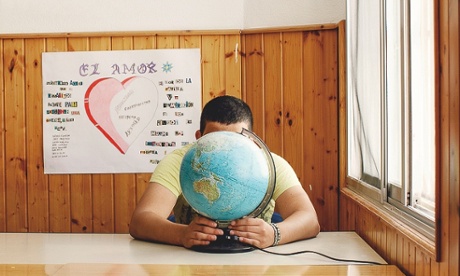
Caffeine and smoking are banned at the centre, cola is allowed only on Saturday and parents can bring sweets on a visit, but the children must share them with other children. Each day, they earn credits for good behaviour – or lose them for bad behaviour. Diego is slightly behind on his tally and says he needs to improve.
Fifteen-year-old Mohamed is in his cell, a room with heavy doors and barred windows. But it is about twice the size of cells in secure training centres and the windows open wide (unlike in the UK, where staff fear contraband being passed along lines). Mohamed has gained enough credits for a television. His clothes and bedding are neatly folded. It is a rule. He says you don’t get anywhere here without obeying the rules.
Mohamed arrived at La Zarza nine months ago and, if all goes well, he has another 13 months left. A handsome boy, with a Cristiano Ronaldo haircut, he is overweight, but says he has already lost three stone due to the good diet at the centre.
He takes out his prayer mat and points it to Mecca. He prays five times a day, he says. Has he experienced racism or bullying? “No. Here you can be straight, gay, black, white, male, female, it’s irrelevant.” (The two girls at La Zarza, whom we don’t meet, have told educators they would prefer to be in a less male-dominated environment.)
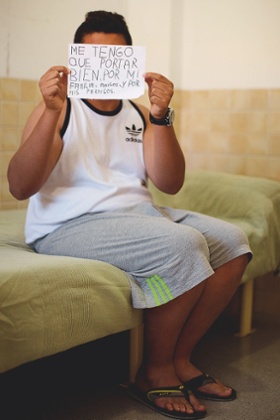
The TV goes off at 10pm from Sunday to Thursday, but they are allowed to watch until 11.30pm on Friday and Saturday. In UK young offender institutions and secure training centres, children tend to shout from their windows when the TV goes off. Does that happen here? “No,” Mohamed says, “we respect that others need to sleep.” There are no toilets in the cells; they must ring a bell and staff open up in a maximum of two minutes. At night, an educator is always in the block, along with a guard. Mohamed says children may ring the bell if they feel upset or lonely and an educator will sit and talk with them.
Mohamed is at a good stage of his development. He leaves the centre regularly, often to help out at local food banks, and is confident he will not reoffend. “I want to be back with my family and show them what I have learned here.” What is the most important thing? “To respect other people. I used to be out all day and night. It drove my parents nuts.” If the environment is so friendly at La Zarza, will he really want to leave? He looks as if he cannot quite believe the question. “This is still a prison,” he says. “This is my punishment.”
***
From the outside, Los Pinos looks like just another large villa. Set in the suburbs of Murcia, its only distinguishing feature is a forbidding electronic gate, which is wide open and remains so until nightfall. Los Pinos is a secure children’s home run by Diagrama. England and Wales also have secure children’s homes (SCHs), widely recognised as delivering better practice than secure training centres (STCs) or young offender institutions (YOIs). But they are so expensive that the government plans to scrap them.
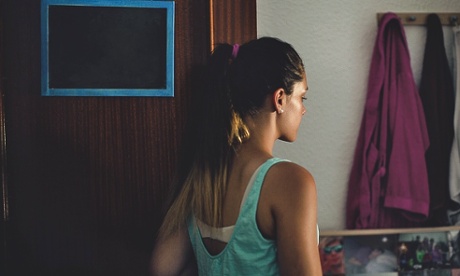
The cost of keeping a child in a British STC is £187,000 a year, while SCHs come in at £211,000 a year. At about £70,000 a child a year, the cost in Spain is around a third of its British equivalent (costs are kept lower by a pared-down administration and more modest pay).
A gaggle of teenagers are streaming out of the villa and piling into a minibus to go swimming with two educators. The staff will not be missed – there are 11 educators to look after the 10 children currently housed here. The centre is mainly for children involved in domestic violence, that is to say, kids who have abused their parents.
Sofia, one of three girls at Los Pinos, is 17 today. She is serving 10 months for abusing her parents and has been here only a few days. As the other children return from swimming, they stop by to kiss her and wish her happy birthday. She wears tracksuit bottoms, her toenails are bright orange, and she exudes attitude. But looks can be deceiving. She says she was “on the floor” when she arrived and is only now starting to gain self-esteem. Her individual programme involves psychology, education and vocational training. Which is the most important? “You cannot choose one,” she says, “you need to put all that stuff together.”
***
Jack, who lives in the north-east of England, can’t remember how many times he appeared in juvenile court before his 15th birthday. He says the court used to sit on Fridays: “So if it was Friday, I would be in court.” On one occasion, aged 12, he was charged with 48 burglaries. Social services told his parents, “Jack has no time for us and we have no time for him.” He has been in every YOI in the north-east of England.
Everything changed when, aged 15 and in Spain visiting relatives, he got high on ecstasy and committed a robbery. He says he was so “out of it”, he can’t remember carrying out the crime. But he can remember his punishment: four years, three in Els Reiets re-educational centre in Alicante and the rest in YOIs in the UK. Six years on, he has not reoffended and cannot imagine doing so.
He describes his experience in Spain as “a bit of a miracle, to be honest”. Initially, he “kicked off” in the centre, arguing with staff and breaking the rules. “Then I realised the educators were trying to help me. They were teaching me life lessons, things I had never learned before.”
Despite his initial bad behaviour in the Spanish system, he says he was never “twisted up” (restrained). In Britain, it was a regular feature of his time inside. He saw one fight in Spain, a brief skirmish. In the UK, he was knocked unconscious with a pool cue and regularly saw boys having their heads thrust down toilet bowls by other children.
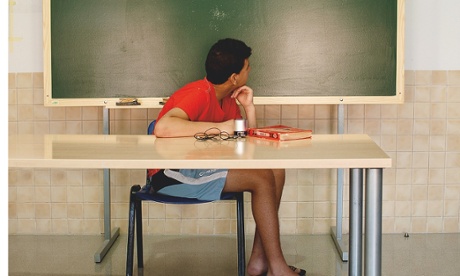
But Jack says he was one of the lucky ones. In 2004 there was a public outcry following two deaths in STCs. Gareth Myatt, aged 15, died after being restrained by three officers in Rainsbrook STC, near Rugby. He had been sent to his room for refusing to clean a sandwich toaster. A custody officer then removed items from his room, including a piece of paper with his mother’s new mobile number on it. Myatt remonstrated and was restrained. He was 4ft 10in and weighed 6st 7lb. One restraining officer was 6ft 1in and 14st. When he told the officers he couldn’t breathe, one replied: “Well, if you are shouting, you can breathe.”
Adam Rickwood, 14, killed himself after being unlawfully restrained by four adult carers at Hassockfield STC, where he had been on remand for just over a month on wounding charges. Officers restrained him using a “nose-distraction” technique (severe tweaking) after he refused to go to his room.
Things were supposed to improve after the deaths of Gareth Myatt and Adam Rickwood, but they didn’t. The Guardian recently revealed that 14 people had been compensated a total of almost £100,000 after being unlawfully restrained in STCs between 2004 and 2008. (The compensation was paid by the Youth Justice Board and private contractors G4S and Serco.) Thirteen of those compensated were now in adult jails.
Despite the Youth Justice Board’s insistence that unlawful restraint stopped in 2008, last year the Guardian reported that, between 2009 and 2011, five teenage inmates at Hindley YOI suffered broken limbs while being restrained. One had his wrist broken twice while being restrained by the same prison officer. In all bar one case, the restraint was unlawful as it was used for non-compliance (it is lawful if an inmate is threatening others or themselves).
The four STCs in England and Wales (and three of the 46 YOIs) are run for profit by G4S or Serco. Such has been the level of criticism of these companies that it has been suggested the government will be reluctant to renew their contracts when they run out next year. Diagrama, which already runs two children’s homes in Luton, is preparing a bid to run two of the secure centres in England, though because of its size (with only 3,000 employees, it is small fry compared with G4S and Serco), it knows it will be awarded only one of the contracts at most.
David Romero McGuire, deputy CEO of Diagrama, has spent the past five years exploring England’s youth detention systems. He accepts that one problem for Diagrama would be staffing – not just the quantity but also the quality: few of the training assistants working in secure centres in England and Wales would be qualified to work as educators. Another problem is the size of institutions. The Spanish centres hold no more than about 90 children. Feltham YOI, for example, holds about 760 – and the government has plans for new academies holding even more.
The cost of living is certainly lower in Spain but, significantly, Diagrama does not exist to make a profit and directors are not paid large salaries – McGuire earns £30,000 a year. He insists it is not the size of the institutions but their guiding ethos that is paramount.
Nathan Ward recently joined Diagrama. Before that he worked for G4S, rising up the ranks at Medway STC over 11 years and running Tinsley House, the immigration removal centre located on the perimeter of Gatwick airport. With his shaved head and bruising handshake, he seems more like a regular prison guard than governor. But his background is surprising: Ward started out as the chaplain at Medway, and has also worked professionally as a magician.
He says it would be wrong to write off youth detention in England: “I’m not going to come out and say people like G4S do a bad job because there are good bits of work that are done in the centres in England.” He talks about the comfort and cleanliness of Medway. But he admits he began to question the culture of youth detention in England, and to look for alternatives. “I read lots of things, like The Hawkspur Experiment. Young boys didn’t go to borstals, but went to work on farms and built stables for the horses and looked after them. I tried to work towards that within the system, but in the end I thought we need to create this thing because it doesn’t exist. Then when I came out here, I thought this is the sort of thing I’ve been dreaming about.”
Ward is keen for us to see a particular centre in the south. “It would be easy to show you our most beautiful centre and ignore the rest, but it’s not all like this. This is one of the ugliest centres I’ve seen.”
Ward is not exaggerating. As we drive towards it, after 500km on the road, it looks like a classic Victorian prison with an intimidating extension that resembles the Maze in Northern Ireland. The local authority, which commissions Diagrama to run the centre, is not keen on publicity and asked us not to name the location or use the director’s full name. The high fences are topped with three layers of razor wire. Diagrama took over its running 15 years ago and many of the austere trappings from the old regime remain. We enter through a series of secure doors and see cells with heavy steel doors complete with Judas holes.
Luis, the director, is a qualified psychologist who has been here since Diagrama took over. Unlike La Zarza, this centre is in the middle of a town, and Luis says at first the local community were scared of having the jail in their midst. But he was determined to show that the children were just “normal kids who had done bad things”.
Children begin their sentence here in the induction unit, for a minimum of two days. The unit is stark – basically cells with a bed – and doubles as a segregation unit. There are two boys working with a couple of educators in there when we arrive. The boys had broken the rules while on a supervised visit outside the centre the day before. Not all Diagrama staff agree with this part of the regime. Ward says the separation of children in this manner is inhuman, and something he would like to see changed.
Outside, though, there are fountains, aviaries and sculptures, all built and maintained by the children. “If they build it, they respect it,” Luis says. There is even a swimming pool, filled with half a dozen excited teenagers. Luis says the media used to perch on ladders outside the jail and take pictures of the gardens and pool. The rightwing press calls the prison a permanent holiday resort for murderers, while those on the left see these jails as harsh and argue that children should not be detained in the first place.
Luis says this will always be a prison, but he is determined to make it as pleasant an environment as possible. The next step is to remove the rolled razor wire from the tops of the fences. “We don’t need it, the regime is our security,” he says.
Our last stop is the “autonomous block” where children about to leave spend their final weeks. There are no staff here. The children cook, clean and look after themselves without supervision. Eighteen-year-old Felipe has been at the jail almost two years and is about to rejoin his family. He is full of hope for the future and thinks the “measures” the state took against him are the best thing that has happened to him. He is confident he will not return.
But Luis says a high percentage of children fail at the autonomy stage, unable to cope with the decision-making. They then go back a stage. “It’s the process of discovery. Best to find out what you can’t cope with while you are still here.” Of course, some children do fail in the community. Luis says about three a year are returned for further measures.
Two weeks ago, Luis led the closing programme for children about to go back to their communities. “There is nothing more satisfying than when parents say, ‘Thank you, we have our son back.’”
He says that people still ask him how he can work with children who have committed such serious crimes, and he finds it baffling. What does he reply? “How can I not? It is a perfect job.”
Some names have been changed.
Tough love: is this a model prison for children? | Society | The Guardian
.
.
.
No comments:
Post a Comment